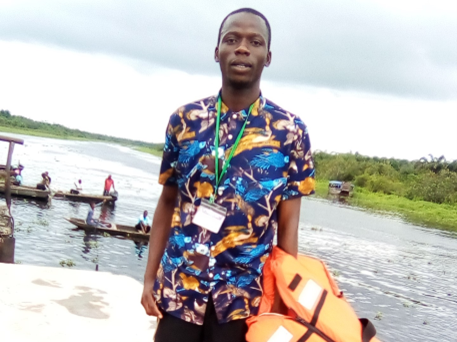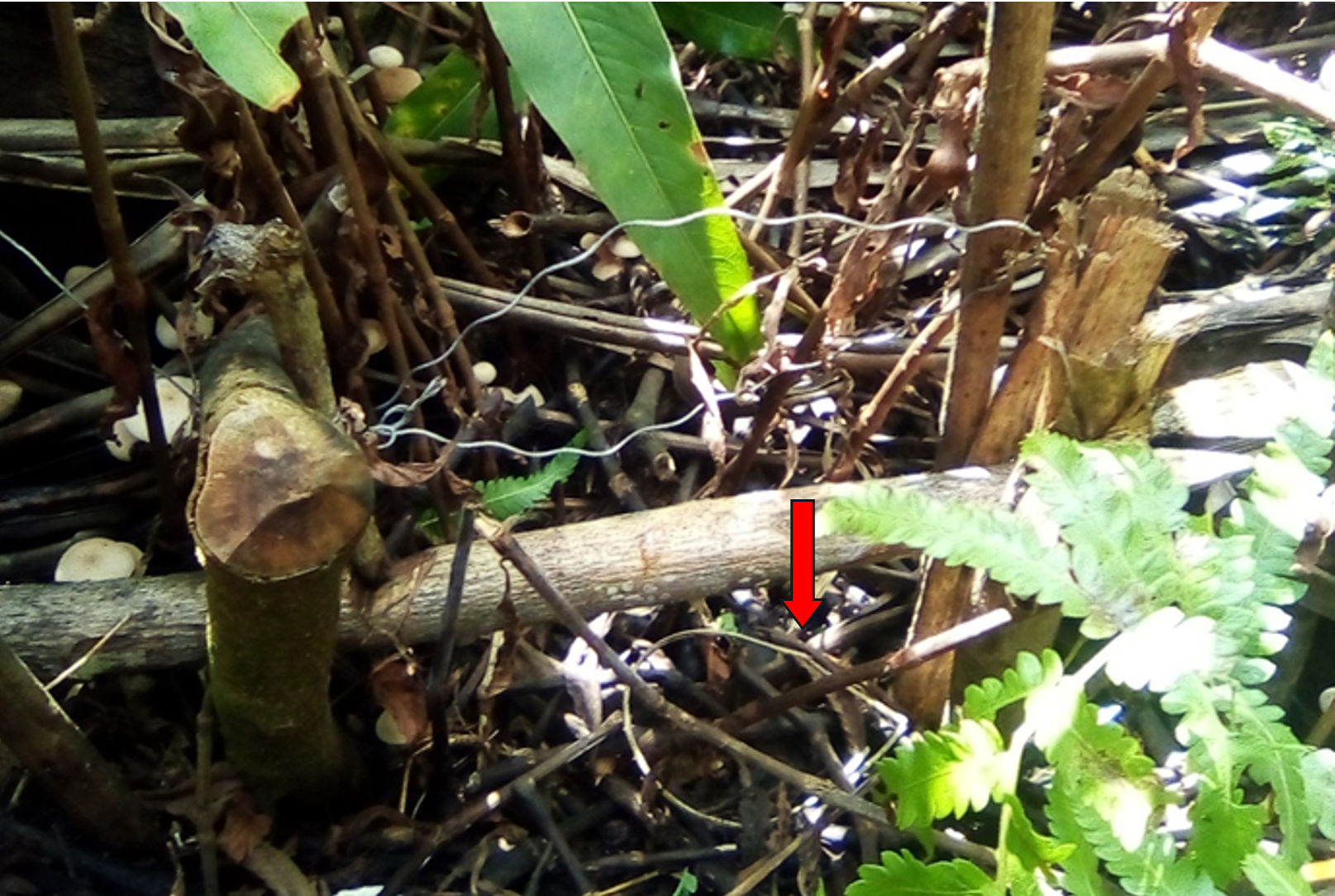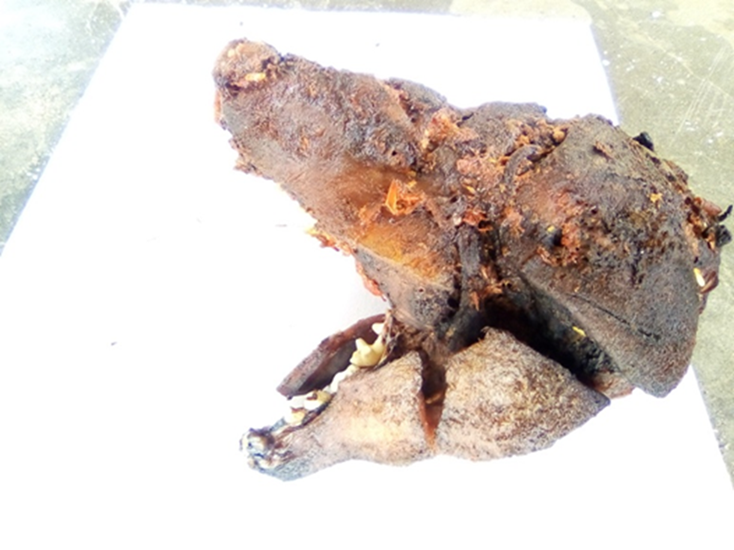IUCN/SSC Otter Specialist Group Bulletin

©IUCN/SCC Otter Specialist Group
Volume 40 Issue 4 (October 2023)
Citation: Salami, O. (2023). Distribution Pattern, Threats and Use of Spotted-Necked Otters (Hydrictis maculicollis) in the Riverine Communities of Ondo State, Nigeria IUCN Otter Spec. Group Bull. 40 (4): 211 - 224
Distribution Pattern, Threats and Use of Spotted-Necked Otters (Hydrictis maculicollis) in the Riverine Communities of Ondo State, Nigeria
Olalekan Salami
Department of Ecotourism and Wildlife Management, School of Agriculture and Agricultural Technology, Federal University of Technology, Akure, Ondo State, Nigeria.
Email: salamiolalekan92@gmail.com
Received 2nd May 2023, accepted 22nd July 2023
Abstract: The goal of the research is to assess the distribution pattern, threats, and use of Spotted-necked Otter, Hydrictis maculicollis, in the riverine areas of Ondo State, Nigeria. Field observations were conducted by walking transects along the banks of the rivers as well as the use of a speedboat/canoe on the water bodies. Focus group discussions (FGD) and key informant interviews (KII) were used to facilitate the research. A total of 51 groups of fishermen/farmers from 17 communities in Ilaje, Irele, Ese-Odo, and Okitipupa local government areas were interviewed. Key informant interviews were carried out where Focus group discussions could not be conducted. These were audio-recorded, after which they were transcribed and analysed qualitatively using thematic analysis. Spotted-necked showed wide distribution in the freshwater ecosystems along the riverbanks, marshy areas, swamps, and streams based on the presence of their indices in the area. During the survey, one dead otter was observed from a fisherman at Olopo, and about 12 skulls and over 500 nets damaged by otter were confirmed in the major river (River Oluwa) and its tributaries in the riverine communities. Direct hunting, with more than 65 set traps, was observed during the survey and accidental capture as well as noise pollution by speedboats was observed in 15 riverine communities as major threats to otter. Increasing demand for otter meat in local restaurants, trade in body parts, and use for traditional medicine in the region pose serious threats to otter populations if not addressed.
Keywords: Habitat, Occurrence; Spotted-necked otter; Threats; Uses; Ondo State
INTRODUCTION
Otters belong to Order Carnivora and Family Mustelidae (Ketmaier and Bernardini, 2005). They are a distinct group of carnivores because of how well they have adapted to a semi-aquatic lifestyle (Kruuk, 2006). They also are an important species in wetlands and one of the main predators in aquatic habitats (Ottino and Giller, 2004). There are 13 living species of otters worldwide, three of which are only found in Sub-Saharan Africa (Lelias et al., 2021). Spotted-necked otters can be found in lakes and bigger rivers over much of southern Africa, and they are thought to be extinct in Burundi, Ghana, Lesotho, and Togo (Reed-Smith et al., 2015). Nigeria is home to two species of otters; the African Clawless otter Aonyx capensis and the Spotted-necked otter Hydrictis maculicollis. A. capensis is found in north-western Nigeria, in theregion of Kainji Lake and Borgu Game Reserve, where it shares habitat with the Spotted-necked otter. A. capensis have been observed in Calabar’s rainforest and the Guinean savannah (Francesco et al., 2005). They are constrained to permanent bodies of freshwater with sufficient shoreline cover and a plentiful prey base (Skinner and Chimimba 2005). Signs of presence have always been recorded close to the water’s edge (Procter, 1963).
The existence of the species is threatened by several issues. Hunting is prevalent in India, and the country is the greatest supplier of otter killed, mostly to meet the enormous demand in the Chinese market (Gomez et al., 2017). Skinner and Chimimba (2005) reported direct and indirect persecution and, perhaps, hunting have an impact on the range of Spotted-necked otters, while also aggravating the loss and deterioration of habitat. Most otters are subject to risk of illegal killing due accidental capture in nets (Harrington et al., 2017). Climate change will seriously affect otters due to their dependence on rivers, lakes, streams, and riparian vegetation for shelter as well as the possible reduction in water levels and droughts as a result of global warming.
Otters are killed all over Africa for their meat, skins, and for medicinal purpose (Reed-Smith et al.,2015). In both rural and urban markets in African towns and cities selling plants and animals for medicine is prevalent (FAO, 2007). The penis of otters was reported to be crushed and mixed with coconut milk to enhance virility (Dong et al., 2010). Otter bile was once used in China to cure anaemia and irregular menstruation (Wang and Carey, 2014).
The Spotted-necked otter is listed on CITES Appendix II (www.cites.org) and classified as Near-threatened with a declining population on the IUCN Red List (Reed-Smith et al., 2015).The range of otters in Nigeria is largely unknown, and information about them comes from museum specimens from a time when this region’s overall ecological characteristics were very different from those of today (Francesco, 2005).In Nigeria, both the African clawless otter and the Spotted-necked otter are very rare, and possibly declining. Little work has been done on the ecology and conservation of the Spotted-necked otter in theSouth West area of Nigeria.Therefore, this research aims to assess the distribution pattern of Spotted-necked otters as well as threats and uses in the riverine area of Ondo State, which will help in further inventory and conservation of the species.
METHODS AND METHODS
Study Area
The research was conducted in the coastal areas of Ondo State, which is in Nigeria’s Southwest region between Latitude 5° 50’ N - 6° 09’ N and Longitude 4° 45’ E - 5° 05’ E. Ondo State’s coastline is around 180 km long. The watershed encompasses an area larger than 2000 km2. It consists of four local government areas. Okitipupa local government is the most populous in this research region, with a population of 234,138 and a land area of 803 km2. They are Ikales-speaking people. Ilaje local government has a land area of 1,318 km2 and is the largest local government in Ondo State in terms of population (129,795). They are part of the Ilaje ethnic group. Ese-Odo local government has an area of 762 km2 and a population of 158, 256 people from the Ijaw and Apoi ethnic groups. The Irele local government has the fewest people (144,136) and the smallest area (963 km2). They communicate in Ikales (National Bureau of Statistics, 2010)(Fig. 1). Commercial activities in these areas are carried out in speedboats and canoes used for transportation of goods and people, petroleum exploration, and the boat building industry (NIPOST, 2017) while fishing and agriculture are the primary occupations of the locals (Kabir et al., 2020).
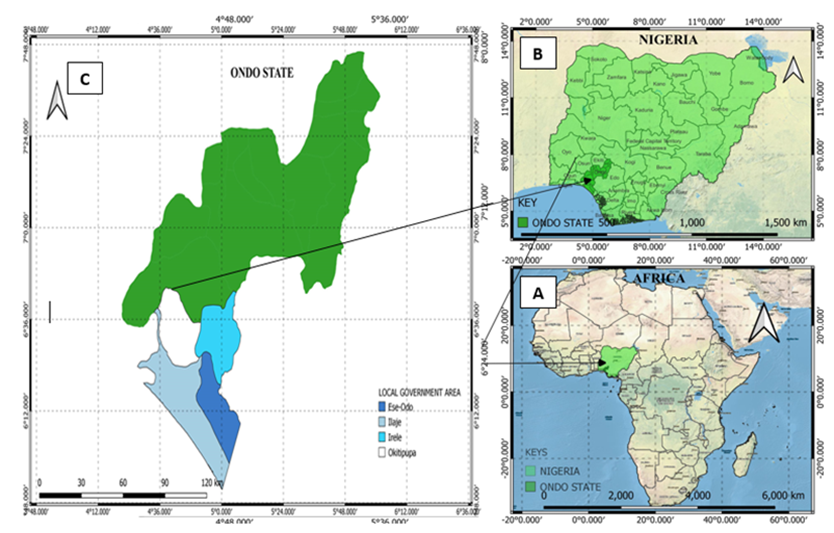
Climate and Biodiversity of the Coastal Areas of Ondo State
The riverine regions have a tropical climate with rainy (April to October) and dry seasons. The typical temperature is 28°C during rainy season, and the average rainfall index is around 3000mm. With a mean temperature of 32 °C and an average rainfall index of 800mm for the dry season (Adesina and Ogunseiju, 2017). The region is drained by several perennial streams and rivers, which pass through several coastal communities before emptying the ocean via an estuary with a water exchange between the coast and the shoreline (Agunbiade et al., 2010). The predominant kind of vegetation in this region is mangrove swamp, particularly the red mangrove Rhizophora racemose and the white mangrove Avicenniaspp typical of swamps. Two to ten months of the year, the area is exposed to tide change and salt water incursion. There are three subzones that border the coastal marshes and creeks; freshwater, brackish water and saltwater (Bolarinwa et al., 2016). The coastal areas are estimated to be about 60,000 hectares in size, rich in biodiversity and home to a variety of fish, shellfish, finfish species, amphibians, reptiles, mammals and other aquatic animals (Solarin et al., 2010).
Data Collection
To estimate the presence of Spotted-necked otters in the area, a reconnaissance survey (February 2020 was conducted among fishermen and farmers as well as individuals in the communities that routinely utilize the coastline and have potential encounters with otters (Fig. 2A,B). This method is appropriate for assessing the relative abundance of some rare species and has been used to measure the abundance of other wild mammals in the hunting terrestrial system (van der Hoeven et al., 2004).
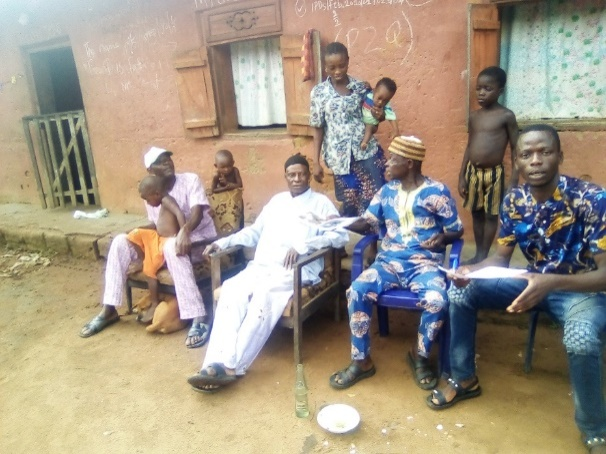
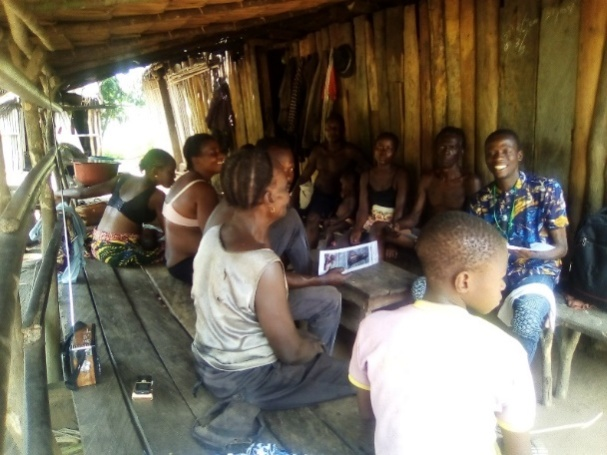
Figure 2B: (left) Key Informant Interview at Akotogbo. Source: Field survey, 2021
Field Observations
Field observations were conducted by walking transects along the banks of the rivers as well as by speedboat or canoe on the water bodies from 6.00am to 11.00am, 3:00pm to 6:00pm and 8:00pm to 10:00pm for 30 days. This involved walking along the river banks to observe otter activities as well as possible threats to its survival. The surveyswere carried out both during the day (to look for otters and signs of their presence) and at night using torchlight (to look for active individuals). The GPS coordinates of the distribution pattern of otters in the study area were taken to generate a distribution map for the species (Fig. 3).
Focus Group Discussions and Key Informant Interviews
Focus group discussions (FGD) and key informant interviews (KII) were used to facilitate the research in 2021. Respondents who had fished for more than 10 years as well as those who work in the aquatic milieu were selected. Subjects included whether respondents had ever seen otters in the area, in what kind of habitat, main activities observed, threats to the otters and use of otter. For ease of identification, otter pictures were displayed to responders, and a native interpreter was used to translate the questions into Ijaw language during the discussions among the Ijaw communities. A total of 51 groups of fishermen/farmers from 17 communities in the four local government areas were interviewed. Key informant interviews were carried out where Focus group discussion could not be conducted. The following communities were selected for the survey;Aboto, Akata, Ipare, Laradha, Olopo and Lekki meta were selected from Ilaje. Agadagba, Arogbo, Enikorogha, Igbekebo and Igbotu were selected from Ese-odo; Akotogbo, Ode Iju-osun and Ode Iyansan were selected from Irele while Erinje, AraromiAyeka and Oloto communities were selected from Okitipupa Local Government Area (Figure 2A,B, Table 1).
Data Analysis
Data on the Focus Group Discussions and Key Informant Interviews were audio-recorded, after which it was transcribed and analysed qualitatively using thematic analysis.
RESULTS
Otter Distribution pattern
The presence of Spotted-necked otter was observed in all the coastal communities sampled (Fig. 3). All the interviewees confirmed to have seen Spotted-necked otter directly in and around the rivers, swamps, streams, and marshy areasas well as indirectly through observation of destroyed nets, partially eaten fish in nets, spraint in forested areas, on logs, and near river banks. Most interviewees confirm to have seen otters primarily in the morning and evening especially during the raining season (Table 2). Otters were generally called “Lombo” among the Ilajes regardless of species and “Okosi” in Ijaw dialect.
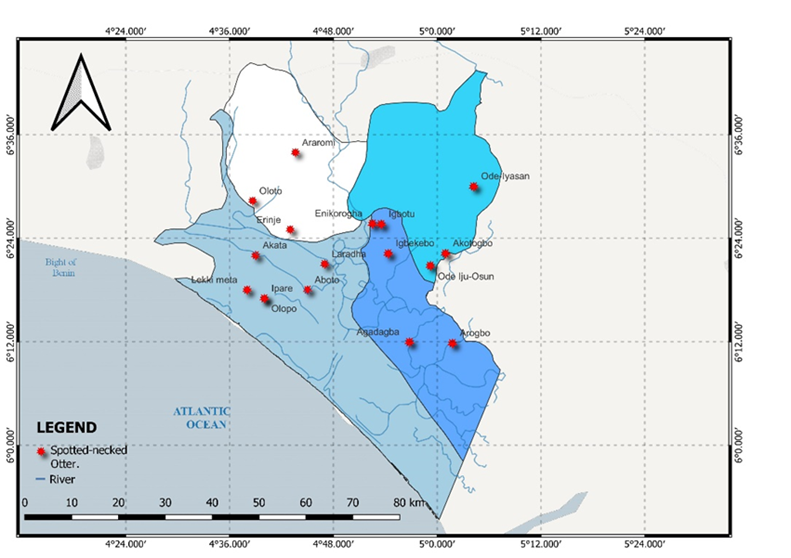
| Table 2: Selection process, variables and rationale for the Focus group discussion and Key Informant Interviews in the riverine areas of Ondo State | |||
| Table Methods | Participants | Selection Criteria and Rationale | |
| · Dead Otter | Field Observation and Focus group discussion/Key Informant Interview | 95% of the interviewees confirmed to have seen dead otter before. | A dead spotted-necked otter was observed from a fisherman at Olopo during survey (Fig. 4). More than 12 otter skulls were seen during the survey (Fig. 5). |
| · Otter parts | Field Observation and Focus group discussion/Key Informant Interview | 82% of the interviewees confirmed to have seen otter parts especially the skulls from hunters/fishermen and market women. | Not encountered during survey |
| · Spraints | Field Observation and Focus group discussion/ Key Informant Interview | 94% of the interviewees agreed to have seen Otter spraints in the area while 6% of the interviewees said they have not seen Otter spraints before. | Not encountered during survey. |
| · Torn Nets | Field Observation and Focus group discussion/ Key Informant Interview | 100% of the interviewees agreed to have observed Otter torn fishing nets. | Over 500 damaged nets was observed through walking transect along the river banks in all the communities surveyed |
| · Footprints/Tracks | 18% of the interviewees agreed to have seen the footprint of Otter 82% of the interviewees disagreed. | ||
| Source: Field Survey, 2021. | |||

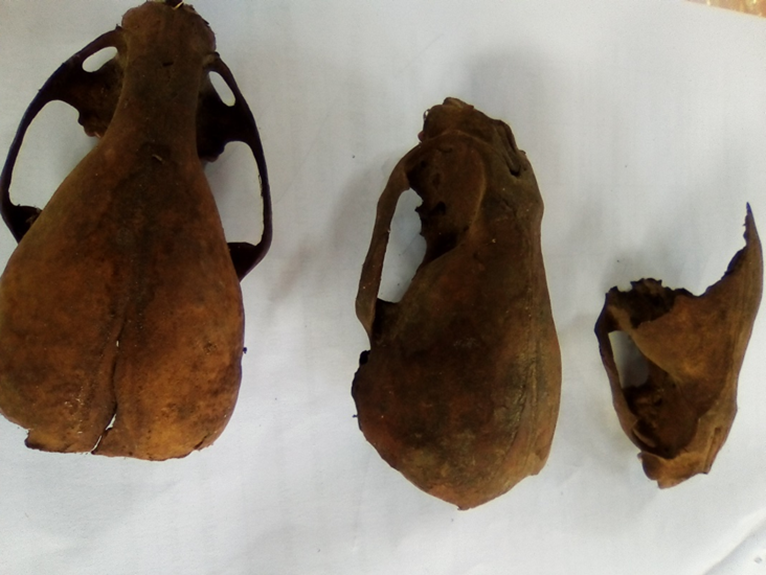
Source: Field survey, 2021.
Threat Factors associated with Spotted-Necked Otters in the Riverine Area of Ondo State
The data indicate that “Direct hunting” is a major threat to Spotted-necked otter in the coastal regions of Ondo State (Table 3).
Ilaje Local Government Area
In Okoha Igbokoda, all the interviewees considered Spotted-necked otter as natural enemy because of the degree and severity of damages to their fishing nets called “Igun” in Ilaje dialect as well as reduction in income due to depravation on fishes within the nets. An Interviewee at Olopo confirmed the killing of a Spotted-necked otter in February, 2021 with his dog. In Ipare, Spotted-necked otter is often hunted particularly by the fishermen and farmers in the area using traps, nets and guns.
Ese Odo Local Government Area
In Igbekedo, Spotted-necked otter was a major delicacy among the Apoi which led to great demand for its meat, and there are several canteens where otter meat was served. Many of the interviewees reported catchingt otters accidentally in fishing nets and with spears. In the same vein, another interviewee reported that noise pollution was a threat to otter survival in the area. In Igbotu, all the people interviewed reported that excessive hunting and accidental capture are threat to otters in the area.
Irele Local Government Area
Most of the interviewees confirmed that spotted-necked otters had been killed in the Akotogbo River with special traps, nets, hook and guns. In Ode-Iju Osun, the interviewees confirmed that spotted-necked otter had been killed frequently with wire traps. An interviewee confirmed that he killed 3 otters in the last four months in 2021. They also reported that noise pollution and habitat degradation pose serious threat to its conservation.
Okitipupa Local Government Area
In Araromi Ayeka, otters were reported to have been killed in Igbinsin-Oloto and in Erinje, Spotted-necked otters have also been killed by farmers and fishermen with guns and wire traps (Fig. 6).
Use of Spotted-Necked Otter in Local Communities
The results revealed that all the interviewees affirmed that Spotted-necked otter serves as food (Fig. 7) and a source of income (Fig. 8). The interviewees stated that various parts of the spotted-necked otter are used for traditional medicine in the selected communities across the four local government regions (Tables 4 and 5).

Field Survey, 2021.
DISCUSSION
Otter Distribution Pattern
The findings reveal that spotted-necked otters are well distributed in all the riverine communities of the four local government areas, and are seen mostly in the morning and evening, especially during the rainy season. This is thought to be due to the abundant of fish species present. They inhabit marshy areas, swamps, and streams of the freshwater ecosystems.This agrees with Kruuk, 2006, who states that spotted-necked otters inhabit only fresh water environments. Perrin and Carranza (2000) reported that Spotted-necked otters use riverine vegetation and rocky riverbanks during the winter dry season, and generally occur where human disturbance is least.
Threats to Otters
It is evident from this study that direct hunting, accidental capture, and noise pollution are the major threats facing Spotted-necked otters in the study area. This is consistent with Acharya (2017): in Nepal, otter populations have declined largely because of degradation of natural habitats and hunting. Ponsonby (2018) reported that expansion of human settlements poses a threat and disturbance to otters, while Trivedi and Joshi (2018) stated that otters are not habituated to human presence.
Uses of Otters
Spotted-necked otters are primarily taken for consumptive purposes in all the communities visited. Spotted-necked otters serve therapeutic purposes which include the treatment of erectile dysfunction in men. This is consistent with findings of Dong et al., (2010), who reported that in Cambodia, an otter’s baculum (penis bone), crushed and mixed with coconut milk, is prescribed as an aphrodisiac. De Luca and Mpunga (2013) also reported on several traditional uses of otters and found that they were eaten in southern Tanzania. In addition, the heads of otters are mixed with other plant parts for making an antidote against bad luck among the Ijaws in the Ese Odo local government area. This agrees with Lev (2003), that animals and products derived from different organs of their bodies have constituted part of medicinal substances used in various cultures since ancient times. Rowe-Rowe (1990) also reported that human hunters kill otters for bushmeat food and for their skins, in part as retribution for their eating fish desired by fishermen. Hadipour et al.(2011) reported that the otter is also hunted for its fur and taxidermy proposes in recent years. Still (2003) reported that the demand created by traditional medicine is one of the causes of the over exploitation of population of numerous animal species.
CONCLUSION
The study revealed that otters inhabit freshwater ecosystems and they are well distributed in different habitats ranging from marshy areas, streams and swamps in the riverine communities of Ondo State. However, excessive hunting, accidental capture as well as noise pollution threaten the survival of this keystone species in its home range. Increasing demand for otter’s meat for food and body parts for economic and traditional uses may further reduce the already declining populations of otter in the riverine communities. The research also confirmed the presence of African clawless otter (Aonyx capensis) in the area, but the scope of work was limited to spotted-necked otter. Therefore, there is need for more conservation education and provision of alternative livelihoods such as mini-livestock production, crafts making and ecotourism initiatives among the locals. Further research should be conducted to extensively study these species in all the coastal communities of Southwestern Nigeria.
Acknowledgements: I appreciate the Department of Ecotourism and Wildlife Management for providing the field equipment during the research. I appreciate Janice Reed-Smith (African Otter Network) and Paul Yoxon (International Otter Survival Fund) for support, encouragement, and passion for otter conservation. I also appreciate Margherita Bandini of the African Otter Network for her love, support, and encouragement. I acknowledge Dr. Hernandez-Romero of Universidad Nacional Autónoma de México, for his advice during the research work. I am grateful to the traditional rulers and community leaders at Ese-Odo, Irele, Ilaje and Okitipupa for allowing me to conduct the research in their communities. Thanks to Dr Abiola Oshodi Foundation for funding this project.
REFERENCES
Acharya, P.M. (2017). Status of Smooth-coated Otters (Lutrogale perspicillata) (Geoffroy, 1826) in the Khauraha River of Bardia National Park, Nepal. Otter, the Journal of the International Otter Survival Fund, 3: 23-37. https://otter.org/documents/journals/IOSF_Journal_Vol3_2017.pdf
Adesina, R.B, Ogunseiju, P.(2017). “An Assessment of Bathymetry, Hydrochemistry and Trace Metals in Sediments of Awoye Estuary in Ilaje Area, Southwestern Nigeria.” Journal of Geosciences and Geomatics, vol. 5(2): 78-86. http://pubs.sciepub.com/jgg/5/2/4
Agunbiade, F.O, Olu-Owolabi, B.I., Adebowale, K.O. (2010). Seasonal and spatial variations analysis of pollution status of Ondo coastal environment, Nigeria, using principal component analysis. Geochemical Journal, 44: 89–98. https://doi.org/10.2343/GEOCHEMJ.1.0048
Bolarinwa, J.B, Fasakin, E.A, Fagbenro, A.O. (2016). The Species Composition and Diversity of the Coastal Waters of Ondo State, Nigeria. ARJA (American Research Journal of Agriculture), 2: 1-7 http://dx.doi.org/10.21694/2378-9018.16002
De Luca, D.W., Mpunga, N.E. (2013). Small carnivores of the Mt. Rungwe-Kitulo landscape,southwest Tanzania: presence, distributions and threats. Small Carn. Cons. Special Issue: Africa, 48: 67-82. https://smallcarnivoreconservation.com/index.php/sccg/issue/view/274/76
Dong, T., Tep, M., Lim, S., Soun, S. and Chrin, T. (2010). Distribution of Otters in the Tropeang Roung, Koh Kong Province, Cambodia. IUCN Otter Spec. Group Bull. 27 (2): 63 – 77 https://www.iucnosgbull.org/Volume27/Dong_et_al_2010.html
FAO (2007). Wildlife utilization and food security in Africa. FAO Corporate Document Repository. www.fao.org.
Francesco, M.A., Edoardo, P., Abraham, J.B., Luca, L. (2005). Distribution and habitat of Otters (Aonyx capensis and Lutra maculicollis) in southern Nigeria, Italian Journal of Zoology, 72(3): 223-227. https://doi.org/10.1080/11250000509356675
Gomez, L, Leupen, B, Theng, M, Fernandez, K., Savage, M, (2016). Illegal otter trade: an analysis of seizures in selected Asian countries (1980–2015). TRAFFIC Report. TRAFFIC, Petaling Jaya, Selangor, Malaysia. https://www.traffic.org/publications/reports/illegal-otter-trade/
Hadipour, E., Karami, M., Abdoli, A., Borhan, R. and Goljani, R. (2011). A Study on Eurasian Otter (Lutra lutra) in Amirkelayeh Wildlife Refuge and International Wetland in Guilan Province, Northern Iran. IUCN Otter Spec. Group Bull. 28 (2): 84 - 98 https://www.iucnosgbull.org/Volume28/Hadipour_et_al_2011.html
Harrington, L.A Marino, J., King, C.M. (2017). People and wild native musteloids. In Macdonald, DW, Newman, C and Harrington, LA, (Eds). Biology and Conservation of Musteloids. Oxford University Press, Pp 189–215. https://doi.org/10.1093/oso/9780198759805.001.0001
Kabir, O.A, Abiodun K.S, Emmauel O.O, Olayinka, E., Olayinka A, (2020). Socioeconomic aspect of African manatee (Trichechus senegalensis): Hunting and capturing in parts of Ogun and Ondo State, southwest Nigeria. American Journal of Agricultural and Biological Sciences, 15(1): 107.117 https://doi.org/10.3844/ajabssp.2020.107.117
Ketmaier, V.,Bernardini, C. (2005): Structure of the Mitochondrial Control Region of the Eurasian Otter (Lutra lutra; Carnivora, Mustelidae): Patterns of Genetics Heterogeneity and Implications for Conservation of the Species in Italy. Journal of Heredity, 96: 318-328. https://doi.org/10.1093/jhered/esi037
Kruuk H. (2006). Otters: Ecology, behaviour and conservation (Oxford, 2006; online edn, Oxford Academic, 1 Apr. 2010), https://doi.org/10.1093/acprof:oso/9780198565871.001.0001
Lelias, M.-L., Lemasson, A., Thierry Lode T. (2021): Social organization of otters in relation to their ecology, Biological Journal of the Linnean Society, Volume 133(1): 1-27. https://doi.org/10.1093/biolinnean/blab016
Lev, E. (2003). Traditional healing with animals (zootherapy): medieval to present-day Levantine practice. Journal of Ethnopharmacology, 85(1): 107-118. https://doi.org/10.1016/S0378-8741(02)00377-X
National Bureau of Statistics (2010). Facts and Figures on Ondo State. https://www.nigerianstat.gov.ng/pdfuploads/FACTS%20&%20FIGURES%20ON%20ONDO%20STATE%20(2010).pdf
NIPOST. (2017). Ilaje with Map of Ilaje LGA. NIPOST
Ottino, P., Giller, P. (2004). Distribution, density, diet and habitat use of the Otter in relation to land use in the Araglin valley, southern Ireland. Biology and Environment: Proceedings of the Royal Irish Academy 104:1-17. https://www.jstor.org/stable/i20500200
Perrin, M.R., and Carranza, I.D. (2000). Habitat use by spotted-necked otters in the KwaZulu-Natal Drakensberg, South Africa. South African Journal of Wildlife Research, 30: 8-14. https://journals.co.za/doi/pdf/10.10520/EJC117092
Ponsonby, D.W. (2018). The ecology of Otters in an urban environment. Doctoral dissertation, University of the Witwatersrand, Johannesburg, https://hdl.handle.net/10539/25759
Procter J. (1963). A contribution to the natural history of the Spotted-necked Otter (Lutra maculicollis) in Tanganyka. African Journal of Ecology, 1: 93-102. https://doi.org/10.1111/j.1365-2028.1963.tb00180.x
Reed-Smith, J., Jacques, H., and Somers, M.J .(2021). Hydrictis maculicollis. The IUCN Red List of Threatened Species, 2021: e.T12420A164578992.. https://dx.doi.org/10.2305/IUCN.UK.2021-3.RLTS.T12420A164578992.en
Rowe-Rowe, D.T. (1990). Otter distribution and protection in South Africa. IUCN Otter Specialist Group Bulletin, 5: 17–23. https://www.iucnosgbull.org/Volume5/Rowe_Rowe_1990a.html
Salami, O.M., Odewumi, O.S., Hernandez-Romero, P.C. (2022). The Perception of Fishermen towards the Conservation of Spotted-necked Otters (Hydrictis maculicollis) and Conflicts with the Riverine Area of Ondo State, Nigeria. OTTER, Journal of the International Otter Survival Fund, 8, September, 2022. https://otter.org/documents/journals/IOSF_Journal_Vol8_2022.pdf
Skinner, J.D., Chimimba, C.T. (2005). The mammals of the southern African sub-region. Cambridge University Press. Pp 35–40. ISBN: 9780521844185
Solarin, B., Williams, A., Hamzat, M., Rabiu, A., Oguntade, O., Bolaji, D. (2010). Report on survey of fish and other living resources of the Nigerian coastal waters conducted between 14th April and 6th June 2009. NIOMR, Lagos, 57.
Still, J. (2003). Use of animal products in traditional Chinese medicine: environmental impact and health hazards. Complementary Therapies in Medicine, 11(2): 118-122. https://doi.org/10.1016/S0965-2299(03)00055-4
Trivedi, K., Joshi, P. (2018).Photographic Documentation and Distribution of Smooth-Coated Otter (Lutrogale perspicillata) (Geoffroy 1826) in Surat, Gujarat. IUCN Otter Spec. Group Bull. 35(1): 31 – 36 https://www.iucnosgbull.org/Volume35/Trivedi_Joshi_2018.html
van der Hoeven, C.A, de Boer, W.F, Prins, H.H.T. (2004). Pooling local expert opinions for estimating mammal densities in tropical rainforests. Journal for Nature Conservation 12: 193–204 https://doi.org/10.1016/j.jnc.2004.06.003
Wang, D.Q., Carey, M.C. (2014). Therapeutic uses of animal biles in traditional Chinese medicine: an ethnopharmacological, biophysical chemical and medicinal review. World J Gastroenterol., 20(29): 9952-9975 http://dx.doi.org/10.3748/wjg.v20.i29.9952
Résumé: Répartition, Menaces et Utilisation de la Loutre à Cou Tacheté (Hydrictis maculicollis) dans les Communautés Lacustres de l’État d’Ondo, au Nigeria
Le but de la recherche est d’évaluer le modèle de répartition, les menaces et l’utilisation de la loutre à cou tacheté Hydrictis maculicollis dans les zones fluviales de l’État d’Ondo, au Nigeria. Les observations sur le terrain ont été réalisées en parcourant des transects le long des berges des rivières ainsi qu’en utilisant un hors-bord/canoë sur les plans d'eau. Des Discussions de Groupe (DG) et des Entretiens avec des Informateurs Clés (EIC) ont été utilisés pour faciliter la recherche. Au total, 51 groupes de pêcheurs/agriculteurs de 17 communautés des territoires de gouvernement local d’Ilaje, Irele, Ese-Odo et Okitipupa ont été interrogés. Des entretiens avec des informateurs clés ont été menés là où les discussions de groupe ne pouvaient pas avoir lieu. Ceux-ci ont été enregistrés en audio, après quoi ils ont été retranscrits et analysés qualitativement par analyse thématique. L’espèce présente une large répartition dans les écosystèmes d’eau douce le long des berges des rivières, des zones marécageuses, des marécages et des cours d'eau, en fonction de la présence de leurs indices dans la région. Au cours de l’enquête, une loutre morte a été trouvée chez un pêcheur à Olopo, environ 12 crânes et plus de 500 filets endommagés par la loutre ont pu être confirmés sur le cours principal de la rivière Oluwa et ses affluents dans les communautés riveraines. Comme menaces majeures sur la loutre, nous avons observé durant l’enquête la chasse directe avec plus de 65 pièges posés, une capture accidentelle ainsi que la pollution sonore par des vedettes rapides de 15 communautés lacustres. La demande croissante de viande de loutre dans les restaurants locaux, le commerce de certaines parties du corps et leur utilisation en médicine traditionnelle dans la région constituent de graves menaces pour les populations de loutres si elles ne sont pas prises en compte.
Revenez au dessus
Resumen: Patrón de Distribución, Amenazas y Uso de las Nutrias de Cuello Manchado (Hydrictis maculicollis) en las Comunidades Ribereñas del Estado de Ondo, Nigeria
El objetivo de la investigación es evaluar el patrón de distribución, las amenazas, y el uso de la Nutria de Cuello Manchado Hydrictis maculicollis en áreas ribereñas del Estado de Ondo, Nigeria. Las observaciones de campo fueron realizadas caminando transectas a lo largo de las barrancas de los ríos, así como mediante el uso de lancha rápida/canoa en los cuerpos de agua. Se utilizaron discusiones en Focus Groups (FGD) y entrevistas con informantes clave (KII) para facilitar la investigación. Fueron entrevistados un total de 51 grupos de pescadores/agricultores, de 17 comunidades en las áreas de gobiernos locales de Ilaje, Irele, Ese-Odo y Okitipupa. Las entrevistas con informantes clave fueron llevadas a cabo cuando no podían realizarse reuniones con Focus-groups. Fueron grabadas, luego de lo cual fueron transcriptas y analizadas cualitativamente utilizando análisis temático. La nutria de cuello manchado mostró una amplia distribución en los ecosistemas de agua dulce a lo largo de las barrancas de ríos, áreas pantanosas, pantanos, y arroyos, en base a la presencia de sus índices en el área. Durante el relevamiento, se observó 1 nutria muerta (de un pescador) en Olopo, alrededor de 12 cráneos y más de 500 redes dañadas por nutrias fueron confirmadas en el río principal (Río Oluwa) y sus tributarios. Se observó caza directa con más de 65 trampas puestas en el terreno, y captura accidental así como contaminación sonora por lanchas rápidas, en 15 comunidades ribereñas, como las principales amenazas a la nutria. La creciente demanda por carne de nutria en los restaurantes locales, el comercio en partes corporales, y el uso para la medicina tradicional en la región son serias amenazas a las poblaciones de nutria si no son encaradas.
Vuelva a la tapa
